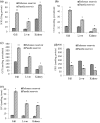Multiple biomarker responses (serum biochemistry, oxidative stress, genotoxicity and histopathology) in Channa punctatus exposed to heavy metal loaded waste water
- PMID: 28490783
- PMCID: PMC5431882
- DOI: 10.1038/s41598-017-01749-6
Multiple biomarker responses (serum biochemistry, oxidative stress, genotoxicity and histopathology) in Channa punctatus exposed to heavy metal loaded waste water
Erratum in
-
Publisher Correction: Multiple biomarker responses (serum biochemistry, oxidative stress, genotoxicity and histopathology) in Channa punctatus exposed to heavy metal loaded waste water.Sci Rep. 2018 Nov 23;8(1):17451. doi: 10.1038/s41598-018-35445-w. Sci Rep. 2018. PMID: 30470781 Free PMC article.
Abstract
Experiments were conducted to investigate the health of fish Channa punctatus inhabiting heavy metal-loaded waste water. Heavy metals in the order of Fe > Mn > Zn > Co > Ni > Cu = Cr were present in the waste water. Gills had high metal load followed by liver and then kidney. Albumin, albumin to globulin (A:G) ratio, triglyceride, high density lipoprotein (HDL) and very low density lipoprotein (VLDL) were found to be lower but phospholipid, low density lipoprotein (LDL), total protein, lipid and cholesterol were higher as compared to the reference. Oxidative stress markers such as superoxide dismutase (SOD), catalase (CAT), glutathione S transferase (GST) and lipid peroxidation (LPO) were significantly higher in all tissues, whereas reduced glutathione (GSH) levels were comparatively low. Damage to DNA was observed with significantly higher mean tail length of comets in the exposed fish gill cells (30.9 µm) followed by liver (24.3 µm) and kidney (20.6 µm) as compared to reference fish (5.2, 4.8 and 5.9 µm respectively). Histopathology in gill, liver and kidney also showed marked damage. Integrated biochemical, oxidative stress, genotoxicity and histopathological findings are valuable biomarkers for native fish adaptive patterns, and monitoring of water quality/pollution of freshwater ecosystems.
Conflict of interest statement
The authors declare that they have no competing interests.
Figures





Similar articles
-
Studies on biomarkers of oxidative stress and associated genotoxicity and histopathology in Channa punctatus from heavy metal polluted canal.Chemosphere. 2016 May;151:210-9. doi: 10.1016/j.chemosphere.2016.02.080. Epub 2016 Mar 15. Chemosphere. 2016. PMID: 26943742
-
Bioaccumulation, oxidative stress and genotoxicity in fish (Channa punctatus) exposed to a thermal power plant effluent.Ecotoxicol Environ Saf. 2016 May;127:163-9. doi: 10.1016/j.ecoenv.2016.01.007. Epub 2016 Jan 30. Ecotoxicol Environ Saf. 2016. PMID: 26829070
-
In vivo induction of antioxidant response and oxidative stress associated with genotoxicity and histopathological alteration in two commercial fish species due to heavy metals exposure in northern India (Kali) river.Comp Biochem Physiol C Toxicol Pharmacol. 2015 Oct-Nov;176-177:17-30. doi: 10.1016/j.cbpc.2015.07.004. Epub 2015 Jul 17. Comp Biochem Physiol C Toxicol Pharmacol. 2015. PMID: 26191657
-
Studies on the oxidative stress and gill histopathology in Channa punctatus of the canal receiving heavy metal-loaded effluent of Kasimpur Thermal Power Plant.Environ Monit Assess. 2015 Jan;187(1):4179. doi: 10.1007/s10661-014-4179-6. Epub 2014 Dec 11. Environ Monit Assess. 2015. PMID: 25492708
-
Fate and Effects of Heavy Metals in Fishes: Antioxidant Defense System, miRNA/Gene Expression Response, and Histopathological Reproductive Manifestations.Biol Trace Elem Res. 2025 Aug;203(8):4326-4346. doi: 10.1007/s12011-024-04478-w. Epub 2024 Dec 9. Biol Trace Elem Res. 2025. PMID: 39652142 Review.
Cited by
-
Seasonal Changes of Growth, Immune Parameters and Liver Function in Wild Chinese Sturgeons Under Indoor Conditions: Implication for Artificial Rearing.Front Physiol. 2022 Apr 19;13:894729. doi: 10.3389/fphys.2022.894729. eCollection 2022. Front Physiol. 2022. PMID: 35514333 Free PMC article.
-
Histopathological fingerprints and biochemical changes as multi-stress biomarkers in fish confronting concurrent pollution and parasitization.iScience. 2024 Nov 19;27(12):111432. doi: 10.1016/j.isci.2024.111432. eCollection 2024 Dec 20. iScience. 2024. PMID: 39687020 Free PMC article.
-
Assessing physiological responses and oxidative stress effects in Rhamdia voulezi exposed to high temperatures.Fish Physiol Biochem. 2024 Apr;50(2):617-633. doi: 10.1007/s10695-023-01294-2. Epub 2024 Jan 4. Fish Physiol Biochem. 2024. PMID: 38175338
-
Effects of Dietary Supplement of Basil Extract on Biochemical and Immunological Parameters and Growth Performance in Oncorhynchus mykiss.Aquac Nutr. 2024 Mar 27;2024:5388049. doi: 10.1155/2024/5388049. eCollection 2024. Aquac Nutr. 2024. PMID: 39555564 Free PMC article.
-
Oxidative stress, inflammation, and steatosis elucidate the complex dynamics of HgCl2 induced liver damage in Channa punctata.Sci Rep. 2024 Apr 22;14(1):9161. doi: 10.1038/s41598-024-59917-4. Sci Rep. 2024. PMID: 38644412 Free PMC article.
References
-
- Akpor OB, Ohiobor GO, Olaolu TD. Heavy metal pollutants in wastewater effluents: sources, effects and remediation. Adv. Biosci. Bioeng. 2014;2:37–43. doi: 10.11648/j.abb.20140204.11. - DOI
-
- Jerome et al. Metal uptake, oxidative stress and histopathological alterations in gills and hepatopancreas of Callinectes amnicola exposed to industrial effluent. Ecotoxicol. Environ. Saf. 139, 179–193, doi:10.1016/j.ecoenv.2017.01.032 (2017). - PubMed
-
- Romeo, M. & Giamberini, L. History of biomarkers. In: Amiard-Triquet, C., Amiard, J. C., Rainboe, P. S. (Eds.), Ecological Biomarkers, Indicators of Ecotoxicological Effects. CRC Press Taylor and Francis Group, Boca Raton London, New York (2013).
Publication types
MeSH terms
Substances
LinkOut - more resources
Full Text Sources
Other Literature Sources
Molecular Biology Databases
Research Materials
Miscellaneous

